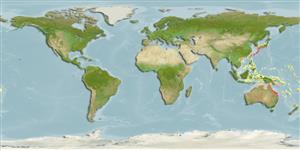>
Blenniiformes (Blennies) >
Blenniidae (Combtooth blennies) > Blenniinae
Etymology: Petroscirtes: Latin, petra, -ae = stone + Greek, skirteo = to jump.
Environment: milieu / climate zone / depth range / distribution range
Sinh thái học
Biển; Thuộc về nước lợ Sống nổi và đáy; Mức độ sâu 1 - 10 m (Ref. 86942). Subtropical
Western Pacific: Queensland, New South Wales, Lord Howe Island, Australia and New Caledonia.
Bộ gần gũi / Khối lượng (Trọng lượng) / Age
Maturity: Lm ? range ? - ? cm
Max length : 13.0 cm TL con đực/không giới tính; (Ref. 2334)
Các tia vây lưng cứng (tổng cộng) : 11; Các vây lưng mềm (tổng cộng) : 19 - 20; Tia cứng vây hậu môn: 2; Tia mềm vây hậu môn: 18 - 20. Jaw teeth incisiform, rigid, close-set, increasing with age; large, curved canine tooth on each side at posterior of lower jaw, and smaller canine on each side at posterior of upper jaw (similar dentition shared within genera); lower end of gill opening above level of pectoral-fin base (also a shared character within genera); small unbranched cirrus on each side of chin; with or without small supraorbital and nuchal cirri; body depth at anal-fin origin 4.5-7.0 SL; males with elongated second dorsal spine; unnotched dorsal fin; caudal fin interradial membranes slightly incised, notably in males; ground color variable with habitat, gray, brown, or green, with 6 large, uneven dark blotches on upper side and numerous white dots and dashes and, ventrally, dark dots. Anal soft rays rarely 18; pectoral soft rays typically 14; segmented caudal rays 1, unbranched (Ref. 54980).
Adults hide in seagrasses, seaweeds, or empty mollusk shells. Oviparous (Ref. 205). Mature females lay eggs on the inner surface of dead bivalve shells which are guarded by the male (Ref. 2334). Larvae are planktonic, often found in shallow, coastal waters (Ref. 94114).
Life cycle and mating behavior
Chín muồi sinh dục | Sự tái sinh sản | Đẻ trứng | Các trứng | Sự sinh sản | Ấu trùng
Oviparous, distinct pairing (Ref. 205).
Randall, J.E., G.R. Allen and R.C. Steene, 1990. Fishes of the Great Barrier Reef and Coral Sea. University of Hawaii Press, Honolulu, Hawaii. 506 p. (Ref. 2334)
IUCN Red List Status (Ref. 130435: Version 2024-2)
Threat to humans
Harmless
Human uses
Các công cụ
Special reports
Download XML
Các nguồn internet
Estimates based on models
Preferred temperature (Ref.
123201): 21.2 - 28, mean 26 °C (based on 599 cells).
Phylogenetic diversity index (Ref.
82804): PD
50 = 0.5005 [Uniqueness, from 0.5 = low to 2.0 = high].
Bayesian length-weight: a=0.00575 (0.00253 - 0.01308), b=3.06 (2.86 - 3.26), in cm total length, based on LWR estimates for this (Sub)family-body shape (Ref.
93245).
Mức dinh dưỡng (Ref.
69278): 2.1 ±0.2 se; based on size and trophs of closest relatives
Thích nghi nhanh (Ref.
120179): Chiêù cao, thời gian nhân đôi của chủng quần tối thiểu là dưới 15 tháng (Preliminary K or Fecundity.).
Fishing Vulnerability (Ref.
59153): Low vulnerability (10 of 100).
Nutrients (Ref.
124155): Calcium = 176 [81, 359] mg/100g; Iron = 1.11 [0.63, 2.17] mg/100g; Protein = 17.5 [16.5, 18.6] %; Omega3 = 0.196 [0.089, 0.417] g/100g; Selenium = 16.6 [7.1, 38.8] μg/100g; VitaminA = 25.1 [7.4, 84.6] μg/100g; Zinc = 2.05 [1.34, 3.10] mg/100g (wet weight);
